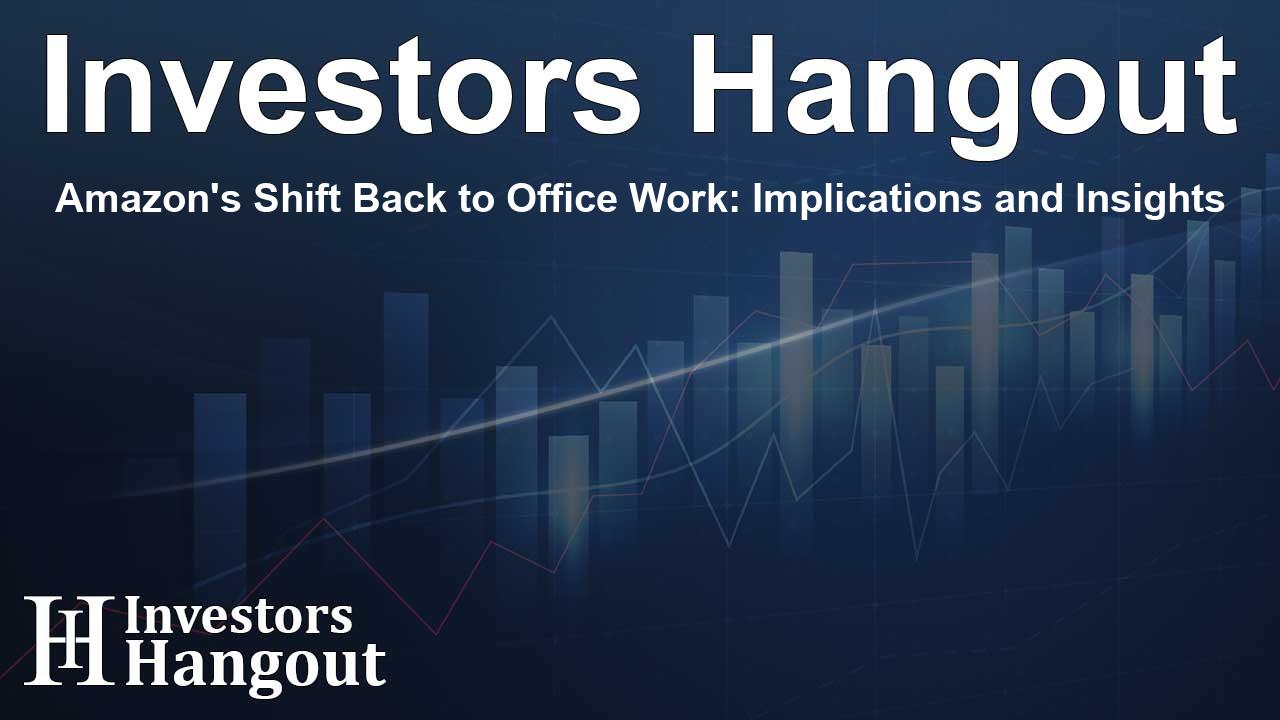Amazon's Shift Back to Office Work: Implications and Insights

Amazon's Policy Change: Embracing Office Work
Amazon.com Inc (NASDAQ: AMZN) has announced its intention to end its remote work policy and require employees to return to the office full-time starting in the new year. CEO Andy Jassy communicated this update via an internal memo, which also outlined shifts in the managerial structure.
The Impact of Ending Remote Work
The decision to eliminate flexible work arrangements will significantly affect many employees. Former Amazon employee John McBride, who previously worked as an Amazon Web Services (AWS) software engineer, expressed his thoughts on the matter, raising questions about the motivations behind such a move.
Perspectives from Former Employees
McBride noted his resignation was influenced by Amazon's demand that he relocate from Denver to Seattle. He believes that the decision to bring employees back to physical offices is primarily aimed at improving economic metrics. His reasoning is that reducing the workforce allows Amazon to enhance profit margins.
Trends in Employment at Amazon
During the pandemic and its aftermath, Amazon expanded its workforce dramatically, adding more than 400,000 employees in 2020 alone. Reflecting on the current situation, McBride suggested that Amazon had overstaffed during that period and has undergone several stages since then, including widespread layoffs and tighter office attendance policies.
A Silent Approach to Layoffs
Justin Garrison, a former senior developer at AWS, elaborated on an approach he coined as "The Silent Sacking." He described a practice at Amazon where the company subtly nudges employees toward resignation instead of direct layoffs. This is achieved by making roles increasingly undesirable through exclusion from important meetings and assigning less engaging tasks.
Cost-Cutting Strategies and Their Implications
This indirect method of workforce reduction enables Amazon to lower operational costs without resorting to publicized layoffs or severance payouts. Garrison’s observations suggest a workplace culture that deliberately sidelines employees to alleviate the burden of layoffs, all while avoiding the potential backlash associated with such actions.
A Closer Look at AWS Profitability
While McBride's concerns regarding the thin profit margins of AWS remain debatable, it's worth noting that AWS has historically maintained strong profitability, with reported margins nearing 40%. Moreover, a mention of tax incentives provided to the company reveals another layer of complexity regarding Amazon's motives for maintaining office-based work.
The Economic Ripple Effects
In 2022, Amazon benefited from over $5 billion in tax breaks and incentives from various states, with a significant chunk originating from Virginia, where the corporation's second U.S. headquarters is located. This locality choice suggests that it actively sought advantageous subsidies from government entities.
Supporting Local Economies
Bringing employees back into offices isn't only a strategic move for Amazon—it also holds potential benefits for local economies. An influx of office workers can stimulate activity in surrounding businesses, including restaurants and local transport services, thus creating a beneficial ripple effect beyond just Amazon’s operations.
Future Outlook for Amazon and Its Employees
As the company transitions back to an in-office model, it opens up discussions about the future workplace expectations and employee perspectives within major corporations. Balancing operational needs with employee welfare remains a pressing challenge for Amazon as they navigate this new phase.
Frequently Asked Questions
Why is Amazon ending its remote work policy?
Amazon wants to improve operational efficiency and profit margins by returning employees to full-time office roles.
What are the concerns from former employees regarding this policy?
Former employees point to economic pressures and a perceived lack of consideration for employee welfare behind the return to office strategy.
How does Amazon's employment strategy affect local economies?
Returning employees to offices can positively impact local businesses, including restaurants and transport services, fostering economic growth in those areas.
What is 'Silent Sacking' as described by former employees?
It refers to a practice where employees are subtly pushed out of the company by making their roles undesirable rather than through direct layoffs.
How has Amazon's staffing changed since the COVID-19 pandemic?
Amazon significantly increased its workforce during the pandemic, but has since moved to downsize and tighten office attendance policies.
About The Author
Contact Lucas Young privately here. Or send an email with ATTN: Lucas Young as the subject to contact@investorshangout.com.
About Investors Hangout
Investors Hangout is a leading online stock forum for financial discussion and learning, offering a wide range of free tools and resources. It draws in traders of all levels, who exchange market knowledge, investigate trading tactics, and keep an eye on industry developments in real time. Featuring financial articles, stock message boards, quotes, charts, company profiles, and live news updates. Through cooperative learning and a wealth of informational resources, it helps users from novices creating their first portfolios to experts honing their techniques. Join Investors Hangout today: https://investorshangout.com/
The content of this article is based on factual, publicly available information and does not represent legal, financial, or investment advice. Investors Hangout does not offer financial advice, and the author is not a licensed financial advisor. Consult a qualified advisor before making any financial or investment decisions based on this article. This article should not be considered advice to purchase, sell, or hold any securities or other investments. If any of the material provided here is inaccurate, please contact us for corrections.
